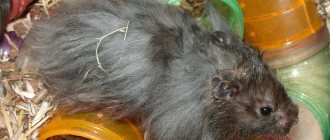All novice owners need to know how to tame a hamster. Cute little animals react painfully to moving; they get excited when they find themselves in a new and unfamiliar place. The owner’s task is to alleviate the pet’s feelings, to do everything to make it comfortable, and for the animal to understand as quickly as possible that it is not in danger. As soon as the hamster realizes that he is in a real family where he is loved, he will become affectionate and friendly. Of course, this does not mean that the pet will sit in the owner’s arms all day, but it certainly will not break free and bite fingers.
What does domesticating a rodent look like?
Taming a hamster at home takes place in several stages. The most important of them is creating comfortable conditions for the animal. The main thing is not to rush, so as not to traumatize the animal’s psyche.
Creating comfortable living conditions for your pet
To gain your hamster's trust and increase its lifespan, you need to give it a spacious, clean cage. The floor is covered with a special underlay, which is updated daily. Additionally, they buy toys for the rodent.
It is important to provide your hamster with access to fresh water and good quality feeding.
The animal only needs 20 g of food per day (vegetables, meat, grain) - this amount is divided into 2 servings. Sometimes the pet is pampered with treats. It is also necessary to ensure that no one disturbs the animal during daytime sleep.
The period of adaptation to a new home
For adaptation to be effective, you need to place the cage in a quiet place. However, it should not be completely isolated - the animal needs to hear the owner’s voice in order to get used to it. It will take your hamster about a week to get comfortable.
The owner is recommended to spend 30-40 minutes a day near the cage - then the animal will be tamed faster.
At this time, you should not make loud noises or try to pull your pet out. Soon he will get used to the owner and will be able to treat him without fear.
Gradually accustoming a hamster to a voice
While near the cage, you need to talk to the hamster. This is done in a gentle tone, preferably during feeding, so that the rodent associates the owner’s voice with the pleasure of eating. Over time, the pet will remember it and will be able to distinguish it from the voices of other people.
Hand feeding with treats
When the owner understands that the pet is accustomed to its new home, you can try to hand feed the hamster. First, treats are given through the bars of the cage, then the palm with the treat is inserted inside, placing the food on the fingertips. The procedure is repeated 3-4 times a day.
When feeding, it is important not to move your hand so as not to scare the animal. If the rodent refuses to leave the hole, you can put sawdust on your palm - this will mask the odors.
If a hamster takes food from your hands, this is the highest degree of trust.
Gentle touches
If the animal runs up to your hand without fear and takes a treat, you can try to gently pet the pet. This should be done carefully and slowly, with one finger. You should not roughly grab the hamster - touches should be light and weightless.
Feeding a hamster outside the cage
While the rodent is walking around the apartment, you should try to feed it outside the cage. To do this, place a treat in the center of the palm and patiently wait for the curious animal to come closer. To eat food, the hamster will have to climb all the way onto your hand.
Attempts to be picked up without food
When the pet stops running away from the owner, you can try to pick it up without using food as bait.
How to tame a hamster:
- You need to stick your palm inside the cage. There is no need to put treats in your palm.
- When the animal climbs onto your hand, carefully pull the pet out.
If the animal is afraid, you must immediately return it back to the cage. You can try to calm your pet by bringing it to your chest - when you hear the heartbeat, the rodent will stop being nervous.
First hold the hamster in your hands, and then you can play with it.
Short description
Domestic hamsters belong to the order of rodents - the most numerous of mammals. They prefer a solitary lifestyle, but with proper training they quickly get used to their owner and love cheerful communication with him. These are crepuscular animals. During the daytime they are inactive and sleep until dusk.
Hamsters have a high metabolism, so they tolerate physical activity well and can run on a “treadmill” of a rotating wheel up to 10 km per day.
Hamsters' vision is poorly developed, they do not react to color changes, but they have an excellent sense of smell and hearing. They orient themselves in space solely by smells and sounds, and are sensitive to touch. They have a good memory and are able to remember family members even after a long separation.
How to properly pick up a rodent
Before paying attention to your pet, you need to wash your hands with soap to eliminate extraneous odors. Considering the small size of the pet, you should handle it carefully, otherwise you may harm the animal.
How to tame a hamster:
- Bring your palm to the cage and let it smell.
- Pet the rodent. If he doesn’t get scared and doesn’t run away, you need to stretch out your hand and wait for the pet to climb on it. If you try to grab the animal from the back, it may bite.
- Pull the animal out of the cage, holding it with your other hand. Hamsters often get injured when falling from heights, so it is important to prevent this from happening.
Care
Keeping animals such as hamsters at home requires some attention and time. First of all, this means frequent replacement of bedding and removal of all uneaten food debris. In addition, you need to wash all the dishes every day, as well as do a general wet cleaning. It is best to place the cage away from the bedroom. In addition, it should not be exposed to sunlight, and there should be no drafts anywhere so that your beloved pet does not catch a cold.
When cleaning the cage, your beloved pet must be transplanted to another place, for example, in a box or jar, since he does not like strangers in his home at all. There is no need to throw away all uneaten food; you should only remove food that will spoil very quickly.
General cleaning needs to be done daily. This is necessary so that the smell of the hamster is not heard throughout the apartment. But it is correct to change the toilet once a week. However, there is no need to completely remove the filler, otherwise the dzhungarik will immediately lose its orientation.
You also need to take care of the hamster itself. They need to be looked after with special diligence. To do this, you need to place a deep container with clean and sifted sand in the cage. He can tumble around in it with pleasure. You should not bathe the hamsters themselves in water, as this will be a real shock for the animal. They can clean themselves.
It must be remembered that Djungarians are loners by nature. Therefore, if you decide to move them into a roommate of any gender, you first need to think carefully about everything. After all, this can lead to aggression or even a small skirmish. In addition, the hamster can become depressed and even die from this. P
How long does it take for hamsters to form attachments?
The adaptation period lasts from 4 to 8 days, and the formation of attachment to the owner can take from a couple of weeks to several months. You cannot force events - the animal must learn to trust the owner.
If the animal is fussing and nervous, this indicates that it is afraid of humans.
It is believed that males are easier to train and tame. Girls are more obstinate and timid, and boys are calm and affectionate.
The hamster must be handled voluntarily and should not be grabbed roughly.
Features of accustoming different species to hands
When buying a hamster, you should pay attention to its breed, since the duration of hand training depends on this.
Dzungarian
“Dzhungariki” are considered the calmest and friendliest, so they easily make contact and quickly get used to the owner. They are more intelligent and intelligent than other species, which makes the training process easier.
Dzungarik in your warm palm shows curiosity about surrounding objects.
Syrian
Syrian hamsters are slow and large in size. The taming process takes longer, but with a good attitude, the pet will willingly go into your arms.
Other types
Campbell's and Roborovsky's hamsters, unlike the "Djungarians" and "Syrians", have a difficult temperament and can be aggressive. You will have to be patient with them, as they are difficult to tame.
Should a small child be trusted with a hamster?
If handled carelessly, it is easy for a pet to be injured and mutilated, so it is important to explain to children how to properly interact with a pet:
- Do not pick up when adults are not present.
- You cannot wave your arms, shout, or hit the animal.
- Do not punish the animal for wrongdoing.
- If a rodent goes into your palm, you need to hold it carefully so as not to crush it.
Small children can only play with animals under the supervision of their parents. If a child is already an adult and wants to take care of a pet on his own, you need to make sure that he is able to do this.
It is better not to leave small children alone with a hamster.
When can you start training your hamster?
If the rodent completely trusts the owner, you can begin training. Young individuals are more receptive to learning, and hamsters older than 3 months have already formed character and habits.
Workout
Classes are held in the evening - at this time the animal demonstrates the greatest activity. It is important that your pet is slightly hungry, otherwise he may ignore treats that are used as rewards.
Before class, you need to thoroughly wash your hands and make sure that the animal is ready to play. You cannot train a lethargic, sleepy or frightened animal.
Tricks
You should start with simple tricks, for example, teaching your pet the “run” command. To do this, you need to take a treat and bring it to the hamster’s nose, clearly say “run” and move your hand along a random path.
When the rodent runs 1 or 2 laps, it is fed a treat and the process is repeated. With regular training, the hamster will soon remember the trick and will perform it without treats. In the same way, you can teach the animal other commands.
Advanced maneuvers
Weight lifting
Obviously, rodents should not lift heavy objects. But to create the effect of heaviness, you can make a barbell from foods that hamsters like to chew: carrots, cucumbers, apples, etc. A block is made from an oblong object; salty or sweet sticks can be used as this. Cookies can serve as mini pancakes for your attribute. When the pet sees the “barbell”, he will certainly want to chew on it, to do this he will lift it and a picture of an athlete with a lifted load will be created.
Pirate and parrot
To create the ambience of a pet sitting on the owner’s shoulder, follow the following instructions:
- Place your pet in your palm.
- Bend your elbow slightly and move it away from your body so that the rise is not too steep.
- Lure your pet to your shoulder with sweets and let your hamster eat it.
- Practice each step repeatedly with your pet.
- When the animal understands what the point is, stop luring the hamster with goodies. Instead, just give him a sniff of the food and immediately place the treat on his shoulder.
Soon your little friend will begin to willingly come running on your shoulder even in the absence of sweets.
Jumping through a hoop
If you want to see your animal jump over obstacles, then use a small hoop for this. The diameter of the circle must be at least 7 cm so that the hamster does not get stuck in it.
- Place the hoop between the animal and a piece of food.
- Keep the circle not too high above the floor (about 1 cm), otherwise the pet will run under it.
- Repeat the exercise several times until your pet can do it without a treat.
Barrier!
- Make a simple design from two disposable cups and toothpicks.
- Place a treat outside the barrier and say: “Barrier!”
- To get a tasty morsel, the fluffy will have to overcome an obstacle.
- After several strengthening of the skill, the animal will be able to jump over the barrier itself after a command.
Unpleasant moments of taming hamsters
During the taming process, the hamster may become aggressive, bite the owner, or get sick. You need to be prepared for difficulties and know how to cope with them.
The rodent constantly bites
If an animal attacks its owner, the reasons for this behavior are:
- curiosity;
- foreign and pungent odors;
- defensive reaction.
You need to pay attention to the nature of the bites. Affectionate and gentle indicate the animal's readiness to play. Strong and aggressive signals about the pet's fear. Pregnant and lactating females can also show aggression - in this case, it is necessary to interrupt physical contact with the animal.
Doesn't eat or drink
If a rodent refuses water and food, this is a sign of severe stress or illness. It is necessary to show your pet to a veterinarian to exclude the possibility of developing the disease. If there are no health problems, you should leave the animal alone so that it can calm down and adapt to its environment.
The hamster is very afraid of humans
Strong fear can be caused by sudden movements, physical violence, or attempts to pull the animal out of the house. It is necessary to identify the cause of fear and eliminate it. Frequent feeding with treats and providing a calm and comfortable environment will help restore your pet's trust.
Basic rules for training a hamster
Physical condition of the animal
You should not start training if your pet has health problems that cause him discomfort. Also, do not disturb the rodent during estrus, mating, or pregnancy. During such periods, hamsters will not be able to exercise to their full potential, and any training will end in failure.
Times of Day
The most suitable time for training is evening. Closer to night, hamsters are at the peak of their activity; they are more resistant to perceiving new information and working through exercises. As soon as your pet gets out of its house after a nap, you can safely start working with it.
Satiety
Train your pet on a moderately full stomach; when hungry, the pet will be distracted by extraneous odors, and the training will fail. Your hands should also be clean and free of food odor.
Confidence
Before a long training process, you need to build a trusting relationship with the rodent, you need to educate it and accustom it to your presence. A strong bond can be established through hand feeding. This way the pet will understand who its owner is and will get used to your smell.
Age
Training a hamster should begin at the right age - from 2 weeks from birth to 2.5 months of conscious life. This period is the most optimal period for training a hamster; at this time, he best perceives information and shows curiosity about the outside world.











